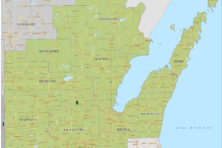The Census, Redistricting and Gerrymandering
- Share
- Tweet
- Pin
- Share
By Joan Korb
For months, signs have been popping up all over Wisconsin: “FAIR MAPS,” they proclaim. Every 10 years, following the constitutionally mandated census, each state redraws its legislative and congressional districts. The U.S. Constitution requires that legislative districts be substantially equal in population, and the Voting Rights Act of 1965 outlawed discriminatory voting practices.
In most states, including Wisconsin, the state legislature creates the new redistricting plan. When one political party controls the legislature, it can draw districts that will ensure its own reelection. To combat a partisan redistricting process, some states have established redistricting commissions.
In Wisconsin, the governor has the power to veto the plan, but if the governor is of the same party as the legislature, the plan will surely be enacted. That happened following the 2010 census, when Republicans controlled the Wisconsin legislature and the governorship. The legislature created districts designed to ensure its members’ reelection for decades. The 2012 election under the Republican redistricting plan of 2011 saw the Republicans win 60 out of 99 seats in the Assembly, despite losing the aggregate statewide vote: With only 49% of the vote, they received 60% of the Assembly seats.
Wisconsin has historically manipulated boundaries to favor one party. The process is known as gerrymandering, following the salamander-shaped district that the Democrat-controlled Massachusetts legislature adopted in 1812. Then-Governor Elbridge Gerry signed the redistricting bill, and the “gerrymander” was born.
In 2011, the Republican plan was the most partisan plan enacted by any Wisconsin legislature, according to the nonpartisan watchdog group Wisconsin Democracy Campaign. Of the immediate court challenges to the redistricting, one was successful: A federal court ruled that the redistricting violated the Civil Rights Act because the plan diluted the voting rights of Latinx voters. The ruling applied only to several districts in Milwaukee, and only those districts were modified by the court.
Another lawsuit sought to throw out the Republican plan because it was a partisan gerrymander in its intent and effect, violating the equal protection and other rights of Democratic voters. The case went to the U.S. Supreme Court, but before it was ultimately decided, that court in a different case determined in a 5-4 decision that political gerrymandering was not a matter for the federal courts. Wisconsin’s case was dismissed because, as Chief Justice John Roberts wrote, “Federal judges have no license to reallocate political power between the two major political parties, with no plausible grant of authority in the Constitution, and no legal standards to limit and direct their decisions.”
Chief Justice Roberts also said that partisan gerrymandering was “incompatible with democratic principles.” Republican lawmakers spent more than $4 million taxpayer dollars to defend their undemocratic map.
Now, 56 of Wisconsin’s 72 counties have passed resolutions backing fair maps, and 32 counties have passed referendums calling for fair maps. Door County has passed both a referendum by popular vote and a resolution by the county board.
Since the 1970s, the League of Women Voters has championed the creation of a nonpartisan, independent commission to reapportion districts in Wisconsin. The organization states that there is overwhelming voter support for nonpartisan redistricting in Wisconsin.
A 2019 Marquette Law School poll also found that more than 70% of respondents said they preferred a nonpartisan commission to do redistricting. It is time, as the saying goes, for voters to choose their legislators rather than legislators choosing their voters.
The Wisconsin Constitution requires that the legislature reapportion itself “according to the number of inhabitants,” using “single districts” that are “bounded by county, precinct, town or ward lines, to consist of continuous territory and be in as compact a form as possible.” Wisconsin’s current legislative and congressional districts do not fit this mandate.
If the Legislature again draws gerrymandered boundaries, Gov. Evers will surely veto the plan. If the governor and the Legislature cannot agree on a plan, a court will draw the boundaries, as happened after the 2000 census.
But there is a better plan: Create a nonpartisan commission to draw the boundaries, as happens in 14 states. Our neighbor Iowa does this, and Michigan has a commission for congressional and legislative districts.
In these hyper-partisan times, we’re all better served without politics entering into the fair drawing of congressional and legislative maps. Chief Justice Roberts is right: Gerrymandering has no place in a democracy.
Joan Korb is a former Door County district attorney and assistant district attorney. She lives in Egg Harbor.

